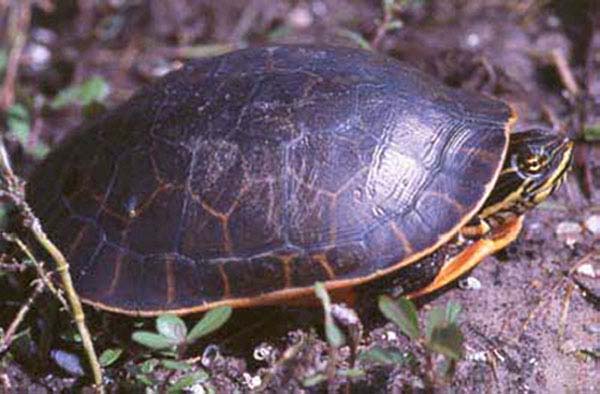Wildlife North America . com North American Animals - mamals, birds, reptiles, insects |
Chicken Turtle (Deirochelys reticularia)
Chicken Turtle Photograph by United States Geological Survey. License: Public Domain. (view image details)
CHICKEN TURTLE FACTS
DescriptionThe Chicken Turtle has a long neck with yellow stripes and a yellow stripe on the forelegs and rear legs. The carapace is olive to dark brown. with a net-like pattern. Females are usually larger than males. Male shave a longer, thicker tail. The Chicken Turtle resembles the Eastern Painted Turtle (Chrysemys picta picta). They spend much of their time basking. Size carapace length 8cm - 11cm. Environment Ponds, lakes, marshes, cypress swamps. They prefer slow moving water with plenty of vegetation and soft bottom. Chicken turtles move over land to find suitable water habitat and can burrow into the soil to escape dry conditions. Food Chicken Turtles are omnivorous and eat crayfish, fish, insects and other invertebrates, frogs. They also eat plant food such as fruit and leaves. Breeding Chicken Turtles nest in the fall and winter. Females dig a cylindrical nest on land in range of soil types from sandy to heavy. She lays 2 to 19 eggs which hatch after about 152 days. Incubation temperature influences the sex of the hatchlings, with all males hatching at 25 degrees Celsius, and mostly females at 30 degrees Celsius. Chicken turtles can live to 20 to 24 years of age. Range Chicken Turtles are found in south eastern United States from Virginia to Texas and north to Oklahoma and Arkansas. There are three subspecies: The Florida Chicken Turtle (Deirochelys chrysea) is found in Florida. The Eastern Chicken Turtle (D. reticularia reticularia) and Western Chicken Turtle (D. reticularia miaria) are separated by the Mississippi River. Classification
Home | Mammals | Reptiles | Birds | Insects | Privacy Policy | Disclaimer | Contact Us |